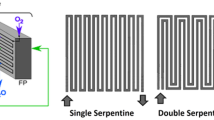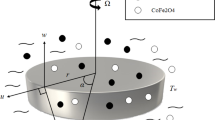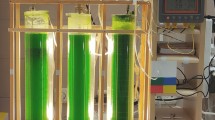Abstract
The lattice Boltzmann method is adopted to simulate hydrodynamics and mass transfer accompanying with biochemical reaction in a channel with cylinder bundle, which is the scenario of biohydrogen production by photosynthetic bacteria in the biofilm attached on the surface of cylinder bundle in photobioreactor. The effects of cylinder spacing, Reynolds number and cylinder arrangement are investigated. The numerical results reveal that highest glucose concentration and the lowest hydrogen concentration are obtained at the front of the first row cylinders for all cases. The staggered arrangement leads to an increment in average drag coefficient, Sherwood number and consumption efficiency of substrate under a given condition, and the increment in Sherwood number reaches up to 30 %, while that in drag coefficient is around 1 %, moreover, the increment in consumption efficiency reaches the maximum value of 12 %. The results indicate that the staggered arrangement is beneficial to the mass transfer and biochemical reaction.









Similar content being viewed by others

Abbreviations
- c :
-
Lattice speed (m s−1)
- C x :
-
Cell density (kg m−3)
- D :
-
Cylinder diameter (m)
- D σ :
-
Diffusivity coefficient of σ-species (m2 s−1)
- C D :
-
Drag coefficient
- e i :
-
Discrete particle velocity in LBE model (m s−1)
- \(f_{i} , { }f_{i}^{eq}\) :
-
Density distribution function and corresponding equilibrium distribution function of the ith discrete velocity
- \(f_{i}^{ + } ({\mathbf{x}}_{w} ,t)\) :
-
Post-collision distribution function at the node x w
- \(\overline{{f_{i}^{eq} }} \left( {{\mathbf{x}}_{w} } \right)\) :
-
Approximated equilibrium part at the node x w
- F :
-
The total force acted on the fluid by the solid body (J m−1)
- \(g_{i,\sigma } , { }g_{i,\sigma }^{{^{eq} }}\) :
-
Concentration distribution function and corresponding equilibrium distribution function of σ-species
- J 0 :
-
Rest fraction
- J i,σ , K i :
-
Specially chosen constants
- k s :
-
Monod constant (kg m−3)
- Ma:
-
Mach number
- p :
-
Fluid pressure (Pa)
- Pe:
-
Peclet number
- Re:
-
Reynolds number
- r σ :
-
React rate of σ-species (kg m−3 s−1)
- R σ :
-
Dimensionless react source term of σ-species
- Sc:
-
Schmidt number
- Sh:
-
Sherwood number
- t :
-
Time (s)
- u :
-
Flow velocity (m s−1)
- \(\overline{{{\mathbf{u}}_{w} }}\) :
-
Approximation of velocity at node x w (m s−1)
- s 1, s 2 :
-
Horizontal and vertical cylinder spacings (m)
- S 1, S 2 :
-
Dimensionless horizontal and vertical cylinder spacings
- x :
-
Cartesian position vector (m)
- Y x/s :
-
Cell yield
- α :
-
Specific area (m−1)
- Δ:
-
Fraction of the intersected link in the fluid region, \(\Delta = | {{\mathbf{x}}_{f} - {\mathbf{x}}_{b} } |/| {{\mathbf{x}}_{f} - {\mathbf{x}}_{w} } |\)
- δ t :
-
Time space (s)
- δ x :
-
Lattice space (m)
- ν :
-
Kinematical viscosity (m2 s−1)
- ρ :
-
Flow density (kg m−3)
- \(\overline{{\rho_{w} }}\) :
-
Approximation of density at the node x w (kg m−3)
- τ ν :
-
Dimensionless relaxation time
- τ σ :
-
Dimensionless relaxation time related to the diffusion coefficient
- w i :
-
Weight coefficient
- μ max :
-
Maximum specific growth rate (s−1)
- η :
-
Substrate consumption efficiency per cylinder’s surface
References
Kapdan IK, Kargi F (2006) Bio-hydrogen production from waste materials. Enzyme Microb Technol 38:569–582
Goltsov VA, Veziroglu TN, Goltsova LF (2006) Hydrogen civilization of the future–A new conception of the IAHE. Int J Hydrogen Energy 31:153–159
Chen CY, Chang JS (2006) Enhancing phototropic hydrogen production by solid-carrier assisted fermentation and internal optical-fiber illumination. Process Biochem 41:2041–2049
Lin CN, Wu SY, Chang JS (2006) Fermentative hydrogen production with a draft tube fluidized bed reactor containing silicone-gel-immobilized anaerobic sludge. Int J Hydrogen Energy 31:2200–2210
Zhang ZP, Show KY, Tay JH, Liang DT, Lee DJ (2008) Biohydrogen production with anaerobic fluidized bed reactors—a comparison of biofilm-based and granule-based systems. Int J Hydrogen Energy 33:1559–1564
Tian X, Liao Q, Zhu X, Wang Y, Zhang P, Li J, Wang H (2010) Characteristics of a biofilm photobioreactor as applied to photo-hydrogen production. Bioresour Technol 101:977–983
Wang YZ, Liao Q, Zhu X, Tian X, Zhang C (2010) Characteristics of hydrogen production and substrate consumption of Rhodopseudomonas palustris CQK 01 in an immobilized-cell photobioreactor. Bioresour Technol 101:4034–4041
Zhang C, Zhu X, Liao Q, Wang Y, Li J, Ding Y, Wang H (2010) Performance of a groove-type photobioreactor for hydrogen production by immobilized photosynthetic bacteria. Int J Hydrogen Energy 35:5284–5292
Liao Q, Liu DM, Ye DD, Zhu X, Lee DJ (2011) Mathematical modeling of two-phase flow and transport in an immobilized-cell photobioreactor. Int J Hydrogen Energy 36:13939–13948
Das D, Badri PK, Kumar N, Bhattacharya P (2002) Simulation and modeling of continuous H2 production process by Enterobacter cloacae IIT-BT 08 using different bioreactor configuration. Enzyme Microb Technol 31:867–875
Chang C, Liu CH, Lin CA (2009) Boundary conditions for lattice Boltzmann simulations with complex geometry flows. Comput Math Appl 58:940–949
Pomeau Y (2007) 20 years of lattice dynamics: a personal view. Int J Mod Phys C 18:437
Raabe D (2004) Overview of the lattice Boltzmann method for nano-and microscale fluid dynamics in materials science and engineering. Model Simul Mater Sci Eng 12:R13
Dupin MM, Halliday I, Care CM, Alboul L, Munn LL (2007) Modeling the flow of dense suspensions of deformable particles in three dimensions. Phys Rev E 75:066707
Keblinski P, Phillpot SR, Choi SUS, Eastman JA (2002) Mechanisms of heat flow in suspensions of nano-sized particles (nanofluids). Int J Heat Mass Transf 45:855–863
He X, Chen S, Zhang R (1999) A lattice Boltzmann scheme for incompressible multiphase flow and its application in simulation of Rayleigh–Taylor instability. J Comput Phys 152:642–663
Shan X, Chen H (1993) Lattice Boltzmann model for simulating flows with multiple phases and components. Phys Rev E 47:1815
Yang ZL, Dinh TN, Nourgaliev RR, Sehgal BR (2001) Numerical investigation of bubble growth and detachment by the lattice-Boltzmann method. Int J Heat Mass Transf 44:195–206
Gabrielli A, Succi S, Kaxiras E (2002) A lattice Boltzmann study of reactive microflows. Comput Phys Commun 147:516–521
Tian Z-W, Zou C, Liu H-J, Guo Z-L, Liu Z-H, Zheng C-G (2007) Lattice Boltzmann scheme for simulating thermal micro-flow. Phys A 385:59–68
Li Q, Zhao K, Xuan YM (2011) Simulation of flow and heat transfer with evaporation in a porous wick of a CPL evaporator on pore scale by lattice Boltzmann method. Int J Heat Mass Transf 54:2890–2901
Yan YY, Zu YQ (2008) Numerical simulation of heat transfer and fluid flow past a rotating isothermal cylinder—a LBM approach. Int J Heat Mass Transf 51:2519–2536
Jeong N, Choi DH, Lin CL (2008) Estimation of thermal and mass diffusivity in a porous medium of complex structure using a lattice Boltzmann method. Int J Heat Mass Transf 51:3913–3923
Onishi J, Chen Y, Ohashi H (2006) Dynamic simulation of multi-component viscoelastic fluids using the lattice Boltzmann method. Phys A 362:84–92
Shan X, Doolen G (1996) Diffusion in a multicomponent lattice Boltzmann equation model. Phys Rev E 54:3614
Verma N, Mewes D, Luke A (2010) Lattice Boltzmann study of velocity, temperature, and concentration in micro-reactors. Int J Heat Mass Transf 53:3175–3185
Yu X, Shi B (2006) A lattice Boltzmann model for reaction dynamical systems with time delay. Appl Math Comput 181:958–965
Sullivan SP, Sani FM, Johns ML, Gladden LF (2005) Simulation of packed bed reactors using lattice Boltzmann methods. Chem Eng Sci 60:3405–3418
Sullivan SP, Gladden LF, Johns ML (2006) 3D chemical reactor LB simulations. Math Comput Simul 72:206–211
FlekkZy EG (1993) Lattice Bhatnagar–Gross–Krook models for miscible fluids. Phys Rev E 47:4247
Qian YH, d’Humieres D, Lallemand P (1992) Lattice BGK models for Navier–Stokes equation. Europhys Lett 17:479
He X, Luo LS (1997) A priori derivation of the lattice Boltzmann equation. Phys Rev E 55:6333–6336
He X, Luo LS (1997) Theory of the lattice Boltzmann method: from the Boltzmann equation to the lattice Boltzmann equation. Phys Rev E 56:6811
Guo Z, Shi B, Wang N (2000) Lattice BGK model for incompressible Navier–Stokes equation. J Comput Phys 165:288–306
Guo Z, Zheng C, Shi B (2002) An extrapolation method for boundary conditions in lattice Boltzmann method. Phys Fluids 14:2007
Kang XY, Liao Q, Zhu X, Yang YX (2010) Non-equilibrium extrapolation method in the lattice Boltzmann simulations of flows with curved boundaries (non-equilibrium extrapolation of LBM). Appl Therm Eng 30:1790–1796
Yang YX, Liao Q, Zhu X, Wang H, Wu R, Lee DJ (2011) Lattice Boltzmann simulation of substrate flow past a cylinder with PSB biofilm for bio-hydrogen production. Int J Hydrogen Energy 36:14031–14040
He X, Doolen G (1997) Lattice Boltzmann method on curvilinear coordinates system: flow around a circular cylinder. J Comput Phys 134:306–315
Mei R, Yu D, Shyy W, Luo LS (2002) Force evaluation in the lattice Boltzmann method involving curved geometry. Phys Rev E 65:041203
Obeid J, Magnin JP, Flaus JM, Adrot O, Willison JC, Zlatev R (2009) Modelling of hydrogen production in batch cultures of the photosynthetic bacterium Rhodobacter capsulatus. Int J Hydrogen Energy 34:180–185
Schäfer M, Turek S (1996) Benchmark computations of laminar flow around a cylinder. In: Hirschel EH (ed) Flow simulation with high-performance computers II, Notes in numerical fluid mechanics, vol 52. Vieweg, Braunschweig, pp 547–566
Feng ZG, Michaelides EE (2002) Interparticle forces and lift on a particle attached to a solid boundary in suspension flow. Phys Fluids 14:49–60
Ladd AJC (1994) Numerical simulations of particulate suspensions via a discretized Boltzmann equation. Part 1. Theoretical foundation. J Fluid Mech 271:285–309
Ladd AJC (1994) Numerical simulations of particulate suspensions via a discretized Boltzmann equation. Part 2. Numerical results. J Fluid Mech 271:311–339
Acknowledgments
The authors would like to acknowledge the joint support of National Science Fund for Distinguished Young Scholars (No. 50825602), National Natural Science Foundation of China (No. 51136007, 20876183), the Fundamental Research Funds for the Central Universities (No. CDJXS 10142223).
Author information
Authors and Affiliations
Corresponding author
Rights and permissions
About this article
Cite this article
Liao, Q., Yang, YX., Zhu, X. et al. Lattice Boltzmann simulation on liquid flow and mass transport in a bioreactor with cylinder bundle for hydrogen production. Heat Mass Transfer 51, 859–873 (2015). https://doi.org/10.1007/s00231-014-1458-2
Received:
Accepted:
Published:
Issue Date:
DOI: https://doi.org/10.1007/s00231-014-1458-2



